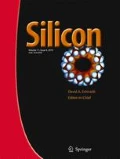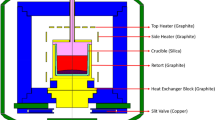Abstract
Multicrystalline silicon (mc-Si) wafers produced by directional solidification still dominate the world market, due to the factor quality/price. The performance of solar cell depends directly to the quality of wafer and impurities distribution in mc-Si ingot. In our study we investigate the distribution of the interstitial oxygen (Oi) and substitutional carbon (Cs), from the bottom to top of the silicon ingot. During the solidification process the solid-liquid interface moves upward with an average growth velocity of 1.2 cm/h, with a slightly convex form. The determination of (Oi) and (Cs) concentrations were performed thanks to the Fourier Transform Infrared Spectrometry (FTIR) technique. The results show that oxygen concentration increases near the crucible wall to the maximum value of 6.3 × 1017 atoms/cm3, and the carbon concentration decrease from maximum value of 9.59 × 1017 atoms/cm3 in the top to the minimal value of 7.84 × 1017 atoms/cm3 in the bottom of ingot. The concentration of global carbon and oxygen in the centre and corner bricks was investigated using the Secondary Ion Mass Spectroscopy (SIMS) technique. The concentration of oxygen and carbon in the center bricks were 1.8 1018 and 2 1018 atoms/cm3, and in the corner bricks 4.6 × 1019 and 9 × 1019 atoms/cm3, respectively. These results provide quantitative information on the concentration of the light impurities in the as-grown mc-Si and allow an overview of their spatial distribution within the final ingot.
Similar content being viewed by others
References
SubhashChander AP, Sharma A, Nehra SP, Dhaka MS (2015) Impact of temperature on performance of series and parallel connected mono-crystalline silicon solar cells. Energy Rep 1:175–180
Blakers A, Zin N, McIntosh K et al (2013) High efficiency silicon solar cells. Energy Procedia 33:1–10
Hoffmann W (2006) PV solar electricity industry: market growth and perspective. Sol Energy Mater Sol Cells 90:3285–3311
Global Market Outlook for Photovoltaics until 2014, EPIA (2011) http://www.epia.org/fileadmin/EPIA_docs/public/Global_Market_Outlook_for_Photovoltaics_until_2014.pdf. Accessed 31 Jan 11
Popovich A, Geerstma W, Janssen M, Bennett IJ, Richardson IM (2015) Mechanical strength of silicon solar wafers characterized by ring-on-ring test in combination with digital image correlationv. https://doi.org/10.1002/9781119093503.ch28
Matsuo H, Bairava Ganesh R, Nakano S, Liu L, Arafune K, Ohshita Y, Yamaguchi M, Kakimoto K (2008) Analysis of oxygen incorporation in unidirectionally solidified multicrystalline silicon for solar cells. J Cryst Growth 310:2204–2208
Bellmann MP, Meese EA, Arnberg L (2010) Impurity segregation in directional solidified multi-crystalline silicon. J Cryst Growth 312:3091–3095
Raabe L, Pätzold O, IvenKupka JE, SindyWurzner MS (2011) The effect of graphite components and crucible coating on the behavior of carbon and oxygen in multicrystalline silicon. J Cryst Growth 318:234–238
Modanese C, Di Sabatino M, Soiland A-K, Kristian P, Arnberg L (2011) Investigation of bulk and solar cell propreties of ingots cast from compensated solar grade silicon. Prog Photovolt Res Appl 19:45–53
Oudjaout D, Gritli Y, Rahab A, Boullmerka H, Manseri A, Hamadas I, Ahmanache A, Bendir R, Kerkar F, Boumaour M (2005). Growth by the heat exchanger method of multi-crystalline silicon ingot.20th European photovoltaic solar energy conference, Barcelona, Spain: 990–991
Khattak C P and Schmidt F (1996). Automation in HEM silicon ingot production. Conference record of the twenty fifth IEEE photovoltaic specialists: 597–600
Möller HJ, Funke C, Kerbner-Kiel D, Würzner S (2011) Growth and optimization of multicrystallin silicon. Energy pocedia 3:2–12
L. Gedvilas, B. Keyes, T. Ciszek, G. Jorgensen, B. Nelson, Y. Xu, J. Perkins (2003 ). The FTIR Laboratory in Support of the PV Program. Presented at the National Center for Photovoltaics and Solar Program Review Meeting Denver, Colorado NREL/CP-520-33576
Kvande R, Mjøs Ø, Ryningen B (2005) Growth rate and impurity distribution in multicrystallinesilicon for solar cells. Mater Sci Eng A 413–414:545–549
Xi Z, Tang J, Deng H, Yang D, Que D (2007) A model for distribution of oxygen in multicrystalline silicon ingot grown by directional solidification. Sol Energy Mater Sol Cells 91:1688–1691
K. Hoshikawa, X. Huang (2000). Oxygen transportation during Czochralski silicon crystal growth. Materials Science and Engineering B72: 73–79
Hirata H, Hoshikawa K (1988) Defect and impurity engineered semiconductors and devices. Japan. Association. Crystal Growth 15: 207–216
Acknowledgements
The authors are grateful for financial support by the FNR/CRTSE/DGRSDT/MESRS of Algeria.
Author information
Authors and Affiliations
Corresponding author
Additional information
Publisher’s Note
Springer Nature remains neutral with regard to jurisdictional claims in published maps and institutional affiliations.
Rights and permissions
About this article
Cite this article
Kerkar, F., Kheloufi, A., Dokhan, N. et al. Oxygen and Carbon Distribution in 80Kg Multicrystalline Silicon Ingot. Silicon 12, 473–478 (2020). https://doi.org/10.1007/s12633-019-00154-0
Received:
Accepted:
Published:
Issue Date:
DOI: https://doi.org/10.1007/s12633-019-00154-0



